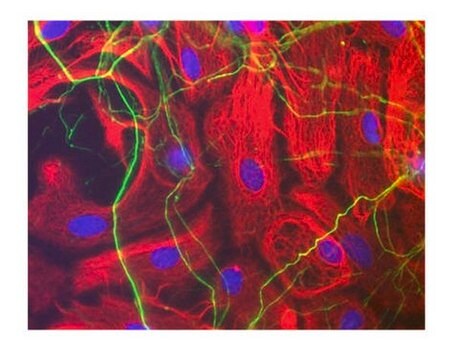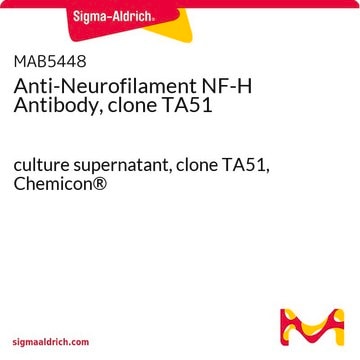MAB1592-C
Anti-Neurofilament NF-H Antibody, phosphorylated Antibody, clone NP1
clone NP1, from mouse
Synonyme(s) :
Neurofilament heavy polypeptide, NF-H, 200 kDa neurofilament protein, Neurofilament triplet H protein
About This Item
Produits recommandés
Source biologique
mouse
Niveau de qualité
Forme d'anticorps
purified antibody
Type de produit anticorps
primary antibodies
Clone
NP1, monoclonal
Espèces réactives
canine, mouse, human, rat
Réactivité de l'espèce (prédite par homologie)
chicken (based on 100% sequence homology), bovine (based on 100% sequence homology), porcine (based on 100% sequence homology)
Conditionnement
antibody small pack of 25 μg
Technique(s)
ELISA: suitable
immunohistochemistry: suitable (paraffin)
western blot: suitable
Isotype
IgG1κ
Numéro d'accès NCBI
Numéro d'accès UniProt
Conditions d'expédition
ambient
Modification post-traductionnelle de la cible
phosphorylation (not specified)
Informations sur le gène
bovine ... Nefh(528842)
chicken ... Nefh(417020)
dog ... Nefh(442940)
human ... NEFH(4744)
mouse ... Nefh(380684)
pig ... Nefh(100156492)
rat ... Nefh(24587)
Description générale
Spécificité
Immunogène
Application
Immunohistochemistry Analysis: A representative lot detected Neurofilament NF-H in Immunohistochemistry applications (Benson, D.L., et. al. (1996). J Neurocytol. 25(3):181-96; Boylan, K., et. al. (2009). J Neurochem. 111(5):1182-91).
Western Blotting Analysis: A representative lot detected Neurofilament NF-H in Western Blotting applications (Benson, D.L., et. al. (1996). J Neurocytol. 25(3):181-96; Boylan, K., et. al. (2009). J Neurochem. 111(5):1182-91).
ELISA Analysis: A representative lot detected Neurofilament NF-H in ELISA applications (Boylan, K., et. al. (2009). J Neurochem. 111(5):1182-91; Toedebusch, C.M., et. al. (2017). J Vet Intem Med. 31(2):513-520; Mashita, T., et. al. (2015). J Vet Med Sci. 77(4):433-8).
Neuroscience
Qualité
Immunohistochemistry Analysis: A 1:50 dilution of this antibody detected Neurofilament NF-H in human cerebral cortex tissue.
Description de la cible
Forme physique
Stockage et stabilité
Handling Recommendations: Upon receipt and prior to removing the cap, centrifuge the vial and gently mix the solution. Aliquot into microcentrifuge tubes and store at -20°C. Avoid repeated freeze/thaw cycles, which may damage IgG and affect product performance.
Autres remarques
Clause de non-responsabilité
Not finding the right product?
Try our Outil de sélection de produits.
Code de la classe de stockage
12 - Non Combustible Liquids
Classe de danger pour l'eau (WGK)
WGK 2
Certificats d'analyse (COA)
Recherchez un Certificats d'analyse (COA) en saisissant le numéro de lot du produit. Les numéros de lot figurent sur l'étiquette du produit après les mots "Lot" ou "Batch".
Déjà en possession de ce produit ?
Retrouvez la documentation relative aux produits que vous avez récemment achetés dans la Bibliothèque de documents.
Notre équipe de scientifiques dispose d'une expérience dans tous les secteurs de la recherche, notamment en sciences de la vie, science des matériaux, synthèse chimique, chromatographie, analyse et dans de nombreux autres domaines..
Contacter notre Service technique







